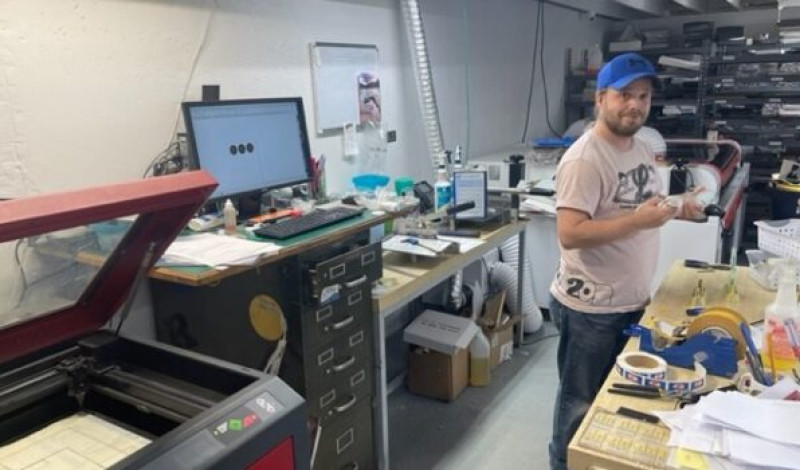Loremans’ Embroidery, Engraving & Screen Printing: The One-Stop Shop Success Story
If ever there was a business that represented convergence, it’s Loremans’. Thom Loreman is the current owner of Loremans’ Embroidery, Engraving & Screen Printing LLC. What began as an operation that ran out of a car trunk now runs a variety of equipment. A short list of what they offer includes screen printing, embroidery, heat transfer, pad printing, wide-format digital printing, and engraving. And of course, that’s just some of it, with things ever evolving.
Being the One-Stop Shop
Thom states that apparel makes up about 55% of the entire business, but he wants to make sure they can service all customers with varying needs. “We always try to add on to existing customers with extra items — not an upsell, but an education,” he says. “I [once] received a call from a nervous assistant [who had] looked all over the internet for someone to help. He needed a T-shirt printed, a hat embroidered, a lava lamp pad printed, and all items placed in a bag with a cover letter and mailed. [They needed] 1,500 pieces total, [and] he had two to three weeks to do this. I said we could do it all. We kept that customer almost 10 years until they went out of business.”
When asked why it’s so important to buy into this convergence method, Thom has one answer: “Being the one to come to, the one-stop shop, is important. Being flexible with [our offering] and almost never saying no makes us different.”
But beyond standing out from the competition, Thom also believes that having such a varied showroom and variety of equipment has not only allowed his business to stay viable through changing times, but also grow. He notes that every step keeps the business moving forward, to stay relevant, and stay in the know.
That’s not to say he wants to put competitors out of business — quite the contrary, actually. Thom is of the mindset that convergence helps everyone, and if he can instill that in others, then that’s considered a win in the printing industry. “We are well versed and pretty stable at all aspects of decoration,” he says. “We share a lot of information, but as we grow, we want the industry to be stronger and vibrant.”
The Convergence Learning Curve
That doesn’t mean it hasn’t come without challenges, though. Thom sheds light on those areas in hopes that others can learn from his experiences. “We once bought a machine to satisfy one customer — bad move!” he says. “[We put] all our eggs in one basket. Once his course was done, we had to find new opportunities [with that equipment].” While that isn’t a great reason to purchase equipment, Thom has certainly turned it around and hasn’t let it stop him from making more moves.
Of course, making those moves and adding new equipment also brings other challenges, like space considerations. “Adding machines has made us change spaces, swap areas, knock out walls (even cut out walls to bring bigger stuff in and then build back walls), add tractors and forklifts … we have rearranged many times,” he states. The lesson here: be ready to make some physical changes.
Beyond that, it also requires things like laptops, software, and even the possibility of more employees and training. “Remember, almost every machine needs a laptop, workstation, network, etc.,” Thom notes. In that sense, it’s critical to stay on top of workflow planning, training, and even cross training when making convergence moves.
That brings to light the topic of learning curves. This was evident when his shop recently invested in direct-to-film (DTF) printing. “We are very graphic savvy, but a newbie would be overwhelmed,” he says of the experience. For those decorators that find themselves stuck in a learning curve, he has a few words of wisdom: “Read, join user groups, pay for training, [and don’t] cheap out.”
This is where communication is key. “Use vendors who will research and strategize with you, not just sell a box and leave,” Thom advises. “You buy the company for most of these items.” He adds that when making purchasing decisions, you must be cognizant of whether you can afford payments and the capital investment that comes with buying equipment.
It is also crucial to communicate with your customers on the flip side. Thom states that utilizing avenues like social media, email, and cold calling can help when you’ve added a new service to your print offerings. “Getting the most from present customers is the best rule — alert them to all you have new and added and that you are the complete package,” he adds.
When it comes down to it, Loremans’ is just one example of why convergence is a strong business strategy for those in the printing world. It’s not about competition, it’s about growing, succeeding, and helping others. “I would most certainly share good and bad experiences as a mentor, trade partner, and future friend,” he finishes.

